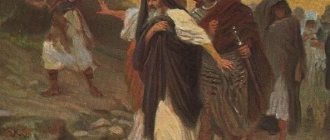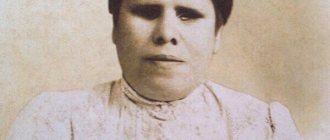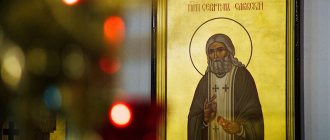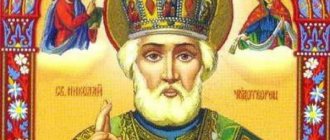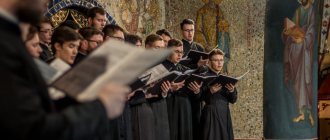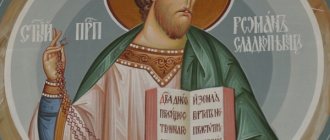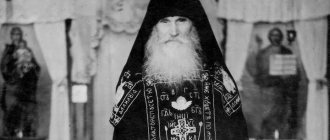| St. David of Gareji. Icon from the Davidogareji Monastery |
David of Gareji
(Georgian: დავით გარეჯელი; + 604), monk, reverend Commemorated on Ascension Thursday and May 7
He was among the Syrian fathers who came to Georgia in the middle of the century with his teacher, the Monk John, who became the educator of the eastern part of the country - Kartli. According to legend, the Mother of God Herself sent the hermit John to the land of Iberia to continue the work of Equal-to-the-Apostles Nino. Having received in a dream the order of the Most Holy Theotokos to choose twelve disciples as his companions, he decided to rely entirely on the Providence of God and chose them by lot. All of them subsequently received their middle names from the places where they founded holy monasteries or occupied episcopal sees.
Leaving his native Antioch and going to Georgia, their teacher brought his children to Simeon the Stylite the Younger (Divnogorets), and he gave them a blessing.
The life of St. John of Zedazni tells how travelers approaching the ancient capital of Georgia, Mtskheta, were greeted with great honor by the clergy and people, led by Catholicos of Kartli Eulalius; how they bowed to the shrines of the Svetitskhoveli Cathedral, among which was the Robe of the Lord, kept in secret; how they went around Eastern Georgia, preaching and, by the grace of God, performing miracles and healings. After some time, Abba John chose Mount Zadeni near Mtskheta as their place of residence, where there had previously been a pagan temple, and the monks had to work hard to cleanse it of evil spirits through prayer and fasting and turn it into a lot of peaceful monastic deeds. Pilgrims began to flock to this first monastery on this land, many of them joined the monastic brethren - the monastery grew, taking on the form of a monastery, with life under the leadership of one abbot and spiritual father, with obediences distributed among the brethren. One day, the Monk John received a message from above that it was time for him to let his spiritual children go - they were to disperse throughout Georgia to found their own monasteries and increase the preaching of Christianity.
David and his disciple Lucian first settled on Mount Mtatsminda (“holy mountain”) near Tbilisi, building in it, following the example of St. John, a small cave and a chapel. Every Thursday they went down to the city and preached. Once, the pagan fire-worshippers bribed a fallen maiden so that she would point to David as her seducer. Having been summoned by the residents to court, the monk approached the woman and, touching her womb with his staff, asked: “Am I your father?” A voice was heard from the womb: “No,” and the true culprit of her fall was named. After this, in front of the surprised people, she gave birth to a stone in pain. In memory of such wondrous heavenly intercession, the Monk David offered a prayer, and a healing spring bubbled up in three places on Mount Mtatsminda. The main one of the three streams collects its waters in a grotto, where the cell of St. David used to be, and now a small temple has been built in honor of the Iveron Icon of the Most Holy Theotokos.
| St. David of Gareji in his life. Icon from the Church of the Life-Giving Trinity on Gryazekh (Moscow). Author Nina Nosova (later nun Tikhon) |
Soon after this, the monks decided that they should completely withdraw from the world.
They found a desert area in Kakheti, on the slope of the Gareji mountain range, about 70 kilometers southeast of Tbilisi. From this moment begins the history of the great shrine of Georgia - the David-Gareji Lavra, until the 20th century, the largest spiritual and cultural center in the Caucasus. The Gareji desert is dry, harsh, in summer it burns with heat of fifty degrees, in winter the frost reaches minus thirty, precipitation occurs only a few times a year. The life of the Monk David tells that, having come to Gareji, the ascetics each carved out a stone bed for themselves in small natural caves of the mountain, prayed in the open air, ate grass, roots and milk, which was given by the wild deer with their cubs who came to them, drank rainwater water, collecting it in depressions carved into the rock. Through the prayers of the Monk David, a holy spring arose here, which later received the poetic name “Tears of David” - of extremely ascetic properties: in fact, it is water oozing little by little through the thickness of the rocks in one of the caves.
Soon the hermits had their first church, carved into the rock and consecrated in honor of the Transfiguration of the Lord. The patron of this small temple was the Rustavi nobleman Bubacar, who believed in Christ after the miraculous healing of the monk and was baptized by him along with all his household.
The ascetics could not remain in their solitude for long. People seeking salvation began to come to them and settle nearby in caves. The first monastery was formed - the one that is now called the Lavra of St. David: many cells carved into the mountain slope.
Nearby, David's followers began to build new monasteries. Dodo of Gareji, with the blessing of his teacher, founded the monastery “Dodos-Rka” (in Georgian - “branch of Dodo”) in the name of the Most Holy Theotokos. Lucian, according to legend, is the Natlismtsemeli (“Baptist”) monastery in the name of the Holy Prophet John the Baptist. The monasteries were organized according to the Syrian cenobitic charter; Anchorites, who shunned all communication, labored alongside them. By the end of the saint's life, about two thousand disciples had gathered around him.
Shortly before his death, the Monk David went to the Holy Land to worship. Having ascended the mountain, from which there was already a view of the Holy City, the monk told his companions that he was not worthy to trample with his feet the places where the Savior’s foot had trodden. He asked to pray for him at the Holy Sepulcher, and with prayer he took three stones from the ground, put them in a knapsack and turned them back. At this time, an Angel appeared to the Patriarch of Jerusalem and said that one of the pilgrims “by his faith took away all the grace from Jerusalem,” and ordered to equip a walker who would take two of the three stones from the monk. David listened to the messengers and returned the requested stones, but he took the third stone to his monastery, and it has been preserved to this day. Now it is kept in the treasury of the new Trinity Cathedral in Tbilisi.
| Burial place of St. David of Gareji in the Davido-Gareji Monastery |
When the hour of his death was revealed to the elder, he gathered all the inhabitants of Gareja and said goodbye to them. The Monk David died after receiving Holy Communion on May 7, 604, Thursday after the Ascension. Therefore, his passing memory is celebrated on this day (Mamadavitoba, Georgian მამადავითობა), and on May 7 - together with the other twelve Syrian fathers. He was buried in the Transfiguration Church of the David-Gareji Lavra. The Monk Lucian later rested there as well. For centuries, their graves were especially revered and were a place of pilgrimage. There is no tradition of finding relics in Georgia; in 2000, they opened the tomb of St. David of Gareji, made sure that the relics were in place, washed them, took a small particle and left everything intact. The Monk David rests peacefully under a bushel near the altar of the ancient Church of the Transfiguration of his monastery.
Life of St. David of Gareji
Traditions do not say when and where the saint was born, only mentioning that he lived in the 6th century. Theologians explain the absence of these facts by the fact that, while still very young, the young man left his parents' home, devoting himself to God.
The Path to Holiness
The beginning of the path of David of Gareji is spoken of in his life. It describes the incident when John received a revelation from the Blessed Virgin Mary. She called on the monk to gather disciples and go around the world, spreading the teachings of Christ. Relying on the will of the Almighty, the abbot chose 13 monks with whom he began his journey. Having reached the capital of Georgia, the city of Mtskheta, from Syria, John dispersed his disciples to other cities so that they would carry God’s Word further.
The Georgian saint is usually depicted as a long-bearded old man
Preaching activities
Having received instructions from the teacher, David of Gareji, together with his student Lucian, decided to settle in Tiflis. Having climbed Mount Mtatsminda, the monk found a secluded cave, where he settled.
Every Thursday the monk visited the city to read the Holy Scripture to its residents. However, such preaching activities were very disliked by the followers of fire worship. One day one of the priests persuaded a pregnant woman to commit a libel against David. The court accused the monk of vicious relationships, saying that he was the father of the unborn child. Then the monk touched the girl’s womb with his staff and asked if it was true. The answer was the word “No” coming from the womb, as well as the name of the true father. According to legend, at that very moment the woman gave birth to a stone, which served as an excuse for the saint.
After this incident, David turned to the Almighty with a request that He would grant him a spring next to his cell. So, for almost fifteen centuries this source has been healing women’s diseases, including infertility.
Soon the monks left Mtatsminda, moving away from the human settlement to the uninhabited mountains of Gareji. There they built their own cells with their own hands, where they continued their ascetic existence, constantly praying and humbly enduring all difficulties. There was no drinking source nearby, and therefore the monks drank water collected after the rain. The teacher and student ate various roots or herbs.
One day, after a prolonged drought, the monks had no food left at all. Then, when Lucian asked what they would eat, David replied that the Lord would take care of everything, if He so pleased. After a short time, deer galloped up to their cell and gave the ascetics milk. Since then, animals regularly visited the monastery of the monks to prevent them from starving to death.
A few years later, like-minded people began to join the two hermits, cutting their own cells next to them. This marked the beginning of the formation of the David-Gareji Lavra.
The end of the earthly journey
The Georgian saint had a presentiment that his days were numbered. Shortly before his death, he decided to visit the Holy Land. Taking two disciples, David reached the border, but refused to go further, arguing that he did not want to desecrate the land on which the Savior walked. The monk sent away his companions, ordering them to pray for him, and he himself stayed for a short time. Kneeling down, the monk picked up three stones and turned back. At the same time, the Patriarch of Jerusalem had a vision. An angel appeared to him, warning him that a certain David had taken away all the Lord’s grace from the land of Israel. The messenger sent returned two stones, and left the third to the monk. Today this shrine is located in the Tbilisi Trinity Cathedral.
The monk left this world on May 20, 604, having said goodbye in advance to all the inhabitants of Gareja. The saint was buried in the Transfiguration Church of the David-Gareji Lavra. His student Lucian was also buried there a little later.
Biography
David was born in southwest Wales - traditionally it is believed that his place of birth was Henwyniv (lat. Vetus Menevia
) near Aberyron (now the county of Ceredigion), but there is a tradition in Pembrokeshire that David was born at Capell Non ("Chapel of Non") near what is now St David's.
His father is given by Welsh sources as King Santa, but this tradition is probably based on a misreading of the Latin manuscript: it said sanctus rex ceredigion
, "holy king of Ceredigion", which was misinterpreted as "Saint, king of Ceredigion".
His mother is called St. Non, whose life was preserved in the Middle Breton record. According to the genealogy of Bonedd yr Arwyr
("The Origin of Heroes")[4] of St. Non was the granddaughter of Uther Pendragon, respectively St. David was considered the great-nephew of King Arthur
About the life of St. Very little is known about David: he was born at the end or at the beginning of the 6th century (there are different traditions on this score - from 462 to 512). It is known that he was the bishop of Menevia (Menopia), a city in southwest Wales (now called after him - St. Davids, in Welsh - Tyddewi, “house of David”), took part in the council in Llandevi-Brevi, where the hierarchs The British Church fought against the heresy of Pelagianism. In 569, he presided over another council (probably also anti-Pelagian) in a place called Lucus Victoriae[5]. Evidence differs regarding the dates of his death. The Annals of Cumbria place his death under the year 603 or 606 (David episcopus Meneuensis obiit[6] and David episcopus moni iudeorum)[7]. However, Geoffrey of Monmouth mentions the death of David, Bishop of Menebean, around 544, and this date - probably taken from Geoffrey - is repeated by many later writers, such as Giraldus of Cumbria and William of Malmesbury. According to legend, David died on Tuesday, March 1st, around the year 590—more precisely, in the year 589, since that's when March 1st falls on a Tuesday.
Cases of miraculous help
David of Gareji is known as the patron saint of women and children. Prayers to him miraculously heal women’s diseases, and also give the spouses a long-awaited child. Eyewitnesses describe many cases of miraculous healing, when even doctors were unable to help and shrugged their shoulders. Such miracles are recalled by one of the clergy of the Tushino Church of the Transfiguration of the Lord.
David of Gareji is the patron saint of women and children
According to him, the Monk David greatly helped the wife of Father Vladimir, a priest of the church, who was carrying her sixth child at the age of 43. Realizing the risk, throughout the entire pregnancy the couple offered prayers to the Georgian saint. They asked him that the birth would be easy and that the child would be born healthy. Shortly before giving birth, the woman drank water over which a prayer service was held to the monk, and also shared it with her neighbors. All of them safely gave birth to healthy children and were discharged from the hospital faster than others.
Another story tells about Father Vyacheslav, whose wife could not get pregnant for 18 years. The former rector of the Tushinsky temple, being a big fan of David Gareji, brought water from a spring on Mount Mtatsminda from his next visit to Tbilisi. Without explaining anything, he gave the vessel to the priest’s wife, and 9 months later the family was replenished with a second child.
Notes
- [www.catholicchurch.org.uk/liturgy/Calendar/National/Wales2.html National holiday calendar] for the Catholic Church in Wales
- [www.cofe.anglican.org/worship/liturgy/commonworship/texts/calendar/holydays.html List of Church holidays] on the Church of England website
- [www.sourozh.org/Calendar/Calendar06.rtf Calendar and lectionary] of the Diocese of Sourozh on March 1
- [www.maryjones.us/ctexts/mostyn117.html Genealogies from Mostyn MS. 117]
- [www.newadvent.org/cathen/04640b.htm The Catholic Encyclopedia]
- [www.kmatthews.org.uk/history/annales_cambrie/ac_b_frames.html Annales Cambriae B] The version probably dates back to the early 13th century; given according to the edition of J. K. ab Itela (1860)
- [www.kmatthews.org.uk/history/annales_cambrie/ac_a.html Annales Cambriae A], given by Phillimore, Egerton Annales Cambrie
// Y Cymmrodor 9 (1888), pp. 141-183
Veneration of the Reverend
The Georgian saint is usually depicted as a long-bearded old man. In one hand he holds a stone from the Holy Land, as a symbol of the inviolability of the Christian faith, and with the other he blesses. There are also icons depicting scenes from the life of David of Gareji:
- lifting three stones from the land of Israel;
- milking deer with Lucian near his cell;
- expulsion of snakes.
Saint David is commemorated on May 20 (the day of his death) and on Thursday after the Ascension of the Lord.
To honor the memory of the saint, it is not necessary to visit Georgia. Services are also held in many Russian churches. For example, Trinity Church in Moscow holds services for the saint every Monday evening.
David-Gareji Monastery in Georgia
Trinity Church in Moscow
Cave temple of the Gareji Lavra
How is St David's Day celebrated?
Until the eighteenth century, this holiday was only religious, but then it acquired a secular character. And today is a national holiday in Wales, which is celebrated on a grand scale throughout the country. This day is also celebrated by residents of other countries whose ancestors were Welsh.
The symbols of the Feast of St. David are the leek/daffodil and the dove. Therefore, on March 1, the streets of the city are decorated with images of a saint with a dove on his shoulder, and those celebrating wear hats with daffodils. Some people attach leeks/daffodils to their clothing.
Children participate in school concerts and choral singing in national costumes.
Traditional food:
- Cawl Cennin onion soup;
- Vali croutons (or “rabbits”) are a national dish made with croutons and a hot, spicy sauce made from processed cheese. Sometimes an egg is served on top. It can be served as a fondue, such as croutons separated from the sauce;
- Bara brit - traditional bread with dried fruits;
- Glamorgan sausages made from Caerphilly cheese and leeks;
- Bakestone Wali are buns about 15mm thick and 8cm in diameter, made in a cast iron pan with a mixture of raisins and spices.
The brightest and largest holiday is St. David's Day in Cardiff, where the main parade takes place. The Prince of Wales or the Queen must visit it.
When to turn to a saint
Women pray to David of Gareji to find happiness in marriage and motherhood. Prayer to the monk helps:
- be happy in marriage;
- heal from infertility;
- safely resolve the burden;
- cure women's diseases;
- get pregnant quickly;
- give birth to a healthy child.
They ask an icon with the face of a saint for a successful marriage
Strong prayers to David of Gareji
Knowing what to ask for, a woman can turn to the monk for help with prayer. Along with it, the troparion and akathist are also read to the Georgian saint.
Oh, all-bright, God-praised Abba David, holy of God! You, by the power of the good Law-giver, have appeared to us, bound and overcome by the snares of the evil one, as a mentor in repentance and a helper in prayer. For this reason, you have been given many gifts of grace and miracles, the resolution of our sins and the remission of sins, the healing of illnesses and the driving away of the devil’s slander. Also, by your fatherly mercy in the divine understanding, by your many laborious prayers and supplications, and especially by your unceasing intercession for us, may the Lord God raise us, who have fallen into sin, with His invincible power against every visible and invisible enemy, so that by giving thanks to your holy memory, with desire We desired to worship the Eternal God in the One Trinity, Father and Son and Holy Spirit, now and ever and unto ages of ages. Amen.
Prayer for infertility
Oh, all-bright, God-praised Abba David, holy of God! You, by the power of the good Law-giver, have appeared to us, bound and overcome by the snares of the evil one, as a mentor in repentance and a helper in prayer. For this reason, you have been given many gifts of grace and miracles, the resolution of our sins and the remission of sins, the healing of illnesses and the driving away of the devil’s slander. Also, by your fatherly mercy in the divine understanding, by your many laborious prayers and supplications, and especially by your unceasing intercession for us, may the Lord God raise us, who have fallen into sin, with His invincible power against every visible and invisible enemy, so that by giving thanks to your holy memory, with desire We desired to worship the Eternal God in the One Trinity, Father and Son and Holy Spirit, now and ever and unto ages of ages. Amen.
Prayer for women's diseases
O reverend and God-bearing Father David, fellow angel and imitator of the Apostle, martyr companion, captor of monastic life, helmsman of the desert, helper of those who pray to you, enlightened by miracles, the lightning of your brilliance invisibly drives away the dark forces. Oh, blessed father, through your prayers deliver us from all evils and evil snares, earthly and airy, from fiery hell. Beg your beloved God to arm us with His Angels, with invincible power. Oh, most bright star, of Divine splendor, be an intercessor before the Holy Trinity, before which you stand, and save us from internecine warfare, and give us a peaceful and serene life, mental and physical health, earth fertility, goodness of the air, enlightenment with Divine light and righteous rest forever and ever, as befitting You, Most Holy Trinity, all glory, honor and worship forever and ever. Amen.
It is not for nothing that the founder of Georgian monasticism is deeply revered in Russian Orthodoxy. With his help, many women have experienced the happiness of motherhood, and the number of those who venerate the saint is constantly growing.
If you find an error, please select a piece of text and press Ctrl+Enter.
Excerpt characterizing David of Wales
Prince Bagration, having reached the highest point of our right flank, began to descend downwards, where rolling fire was heard and nothing was visible from the gunpowder smoke. The closer they descended to the ravine, the less they could see, but the more sensitive the proximity of the real battlefield became. They began to meet wounded people. One with a bloody head, without a hat, was dragged by two soldiers by the arms. He wheezed and spat. The bullet apparently hit the mouth or throat. Another, whom they met, walked cheerfully alone, without a gun, groaning loudly and waving his hand in fresh pain, from which blood flowed, like from a glass, onto his overcoat. His face seemed more frightened than suffering. He was wounded a minute ago. Having crossed the road, they began to descend steeply and on the descent they saw several people lying down; They were met by a crowd of soldiers, including some who were not wounded. The soldiers walked up the hill, breathing heavily, and, despite the appearance of the general, they talked loudly and waved their hands. Ahead, in the smoke, rows of gray greatcoats were already visible, and the officer, seeing Bagration, ran screaming after the soldiers walking in a crowd, demanding that they return. Bagration drove up to the rows, along which shots were quickly clicking here and there, drowning out the conversation and shouts of command. The entire air was filled with gunpowder smoke. The soldiers' faces were all smoked with gunpowder and animated. Some hammered them with ramrods, others sprinkled them on the shelves, took charges out of their bags, and still others shot. But who they shot at was not visible due to the gunpowder smoke, which was not carried away by the wind. Quite often pleasant sounds of buzzing and whistling were heard. "What it is? - thought Prince Andrei, driving up to this crowd of soldiers. – It can’t be an attack because they don’t move; there can be no carre: they don’t cost that way.” A thin, weak-looking old man, a regimental commander, with a pleasant smile, with eyelids that more than half covered his senile eyes, giving him a meek appearance, rode up to Prince Bagration and received him like the host of a dear guest. He reported to Prince Bagration that there was a French cavalry attack against his regiment, but that although this attack was repulsed, the regiment lost more than half of its people. The regimental commander said that the attack was repulsed, coining this military name for what was happening in his regiment; but he himself really did not know what was happening in those half an hour in the troops entrusted to him, and could not say with certainty whether the attack was repulsed or his regiment was defeated by the attack. At the beginning of the action, he only knew that cannonballs and grenades began to fly throughout his regiment and hit people, that then someone shouted: “cavalry,” and our people began to shoot. And until now they were shooting not at the cavalry, which had disappeared, but at the foot French, who appeared in the ravine and fired at ours. Prince Bagration bowed his head as a sign that all this was exactly as he wished and expected. Turning to the adjutant, he ordered him to bring two battalions of the 6th Jaeger, which they had just passed, from the mountain. Prince Andrei was struck at that moment by the change that had occurred in the face of Prince Bagration. His face expressed that concentrated and happy determination that happens to a man who is ready to throw himself into the water on a hot day and is taking his final run. There were no sleep-deprived dull eyes, no feignedly thoughtful look: round, hard, hawk-like eyes looked forward enthusiastically and somewhat contemptuously, obviously not stopping at anything, although the same slowness and regularity remained in his movements. The regimental commander turned to Prince Bagration, asking him to move back, since it was too dangerous here. “Have mercy, your Excellency, for God’s sake!” he said, looking for confirmation at the retinue officer, who was turning away from him. “Here, if you please see!” He let them notice the bullets that were constantly screeching, singing and whistling around them. He spoke in the same tone of request and reproach with which a carpenter says to a gentleman who has taken up an ax: “Our business is familiar, but you will callus your hands.” He spoke as if these bullets could not kill him, and his half-closed eyes gave his words an even more convincing expression. The staff officer joined the admonitions of the regimental commander; but Prince Bagration did not answer them and only ordered to stop shooting and line up in such a way as to make room for the two approaching battalions. While he was speaking, as if with an invisible hand he was stretched from right to left, from the rising wind, a canopy of smoke that hid the ravine, and the opposite mountain with the French moving along it opened before them. All eyes were involuntarily fixed on this French column, moving towards us and meandering along the ledges of the area. The shaggy hats of the soldiers were already visible; it was already possible to distinguish officers from privates; one could see how their banner fluttered against the staff. “They are going nicely,” said someone in Bagration’s retinue. The head of the column had already descended into the ravine. The collision was supposed to take place on this side of the descent... The remnants of our regiment, which was in action, hastily formed and retreated to the right; from behind them, dispersing the stragglers, two battalions of the 6th Jaeger approached in order. They had not yet reached Bagration, but a heavy, ponderous step could already be heard, beating in step with the entire mass of people. From the left flank, walking closest to Bagration was the company commander, a round-faced, stately man with a stupid, happy expression on his face, the same one who ran out of the booth. He, apparently, was not thinking about anything at that moment, except that he would pass by his superiors like a charmer. With a sporty complacency, he walked lightly on his muscular legs, as if he were swimming, stretching out without the slightest effort and distinguished by this lightness from the heavy step of the soldiers who followed his step. He carried a thin, narrow sword taken out at his foot (a bent sword that did not look like a weapon) and, looking first at his superiors, then back, without losing his step, he turned flexibly with his whole strong figure. It seemed that all the forces of his soul were aimed at getting past the authorities in the best possible way, and, feeling that he was doing this job well, he was happy. “Left... left... left...”, he seemed to say internally after every step, and according to this rhythm, with variously stern faces, a wall of soldier figures, weighed down with backpacks and guns, moved, as if each of these hundreds of soldiers was mentally saying, every step of the way: “ left... left... left...". The fat major, puffing and staggering, walked around the bush along the road; the lagging soldier, out of breath, with a frightened face for his malfunction, was catching up with the company at a trot; the cannonball, pressing the air, flew over the head of Prince Bagration and his retinue and to the beat: “left - left!” hit the column. “Close!” came the swaggering voice of the company commander. The soldiers circled around something in the place where the cannonball fell; an old cavalier, a flank non-commissioned officer, falling behind near the dead, caught up with his line, jumped, changed his foot, fell into step and looked back angrily. “Left... left... left...” seemed to be heard from behind the threatening silence and the monotonous sound of feet simultaneously hitting the ground.
